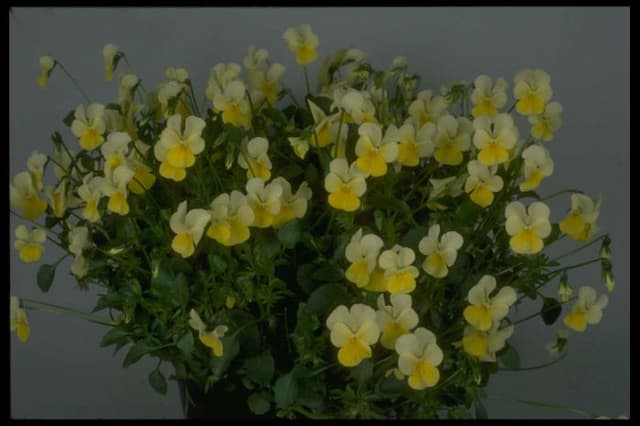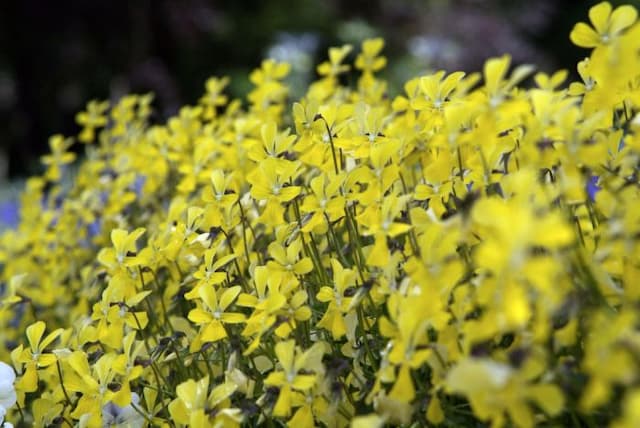Sweet Violet Viola odorata 'Wellsiana' (Vt)

ABOUT
Sweet violet 'Wellsiana' is a charming perennial known for its beauty and fragrance. This plant is characterized by its heart-shaped leaves that provide a lush green backdrop to its stunning flowers. The leaves are typically a deep green color and have a soft, velvety texture. Sweet violet 'Wellsiana' produces an abundance of blossoms that can range from dark violet to blue and even white. The flowers are small but vibrant, with a delicate, almost translucent quality. Each bloom consists of five petals, with the lower petal often sporting a slight spur. The petals are slightly ruffled or curved, which adds to their whimsical appearance. Not only appealing to the eye, sweet violet 'Wellsiana' flowers emit a sweet and enchanting scent that can perfume the air, especially during the early morning or late afternoon. This fragrance has been celebrated for centuries and is often associated with nostalgia and comfort. The plant typically spreads to form low, attractive clumps that contribute to its use as a ground cover in garden settings. While in flower, it can provide a stunning and aromatic display that enhances the sensory appeal of any garden space it inhabits. Its blooming period, under ideal conditions, allows for an extended show of color, maintaining a delightful presence within its given space.
About this plant
 Names
NamesFamily
Violaceae
Synonyms
Sweet Violet, English Violet, Common Violet, Florist's Violet, Garden Violet, Scented Violet, Wood Violet
Common names
Viola suavis 'Wellsiana', Viola hirta 'Wellsiana'
 Toxicity
ToxicityTo humans
Sweet violet is generally considered non-toxic to humans. However, it's important to note that while some parts of the plant have been used historically in herbal remedies and cooking, excessive consumption should be avoided. There are no well-documented cases of poisoning from sweet violet, and it is not known to be toxic when ingested in moderation.
To pets
Sweet violet is not known to be toxic to pets. It is generally considered safe around animals, and there are no common symptoms of poisoning associated with this plant. As with any non-food plant, ingestion in large amounts could potentially cause mild stomach upset, but sweet violet is not recognized as a toxic plant for pets.
 Characteristics
CharacteristicsLife cycle
Perennials
Foliage type
Evergreen
Color of leaves
Green
Flower color
Purple
Height
6 inches (15 cm)
Spread
1 feet (30 cm)
Plant type
Herb
Hardiness zones
5
Native area
Europe
Benefits
 General Benefits
General Benefits- Aesthetic Appeal: Viola odorata 'Wellsiana' has attractive, velvety flowers that add color and beauty to gardens.
- Fragrance: This variety, commonly known as sweet violet, is noted for its delightful, sweet perfume which can enhance the sensory appeal of any space it occupies.
- Wildlife Attraction: The flowers provide nectar for early-season pollinators such as bees and butterflies, thus supporting biodiversity.
- Groundcover: Sweet violet is effective as a ground-cover plant, capable of spreading to cover bare spots and suppress weeds.
- Shade Tolerance: It can thrive in shaded areas where other plants might struggle, making it a versatile choice for different garden situations.
- Edible Parts: The flowers are edible and can be used to decorate or flavor foods, making it a functional plant for culinary enthusiasts.
- Easy Propagation: It can be easily propagated through division, meaning gardeners can create new plants from existing ones without the need for seeds.
 Medical Properties
Medical Properties- Expectorant: Sweet violet is traditionally used to help clear mucus from the respiratory tract.
- Anti-inflammatory: It is believed to have compounds that help reduce inflammation.
- Diuretic: The plant may promote the production of urine to aid in the removal of excess fluids from the body.
- Antiseptic: Sweet violet has been used for its potential antibacterial and antifungal properties.
- Sedative: There is a historical use of sweet violet as a mild sedative to help induce sleep and alleviate anxiety.
- Skin Health: Sweet violet has been applied externally to treat various skin conditions and to soothe irritation.
 Air-purifying Qualities
Air-purifying QualitiesThis plant is not specifically known for air purifying qualities.
 Other Uses
Other Uses- Perfumery: The sweet scent of sweet violet is used in the production of perfumes and fragrances, imparting a delicate and classic floral note.
- Flavoring Agent: Extracts of sweet violet are used to flavor sweets, beverages, and desserts such as syrups, pastries, and confectionaries.
- Insect Repellent: The plant can be used as a natural repellent by placing it among clothes to ward off moths and insects.
- Dye Production: The flowers of sweet violet can be used to produce a natural dye for textiles, yielding hues of blue and purple.
- Garden Design: Sweet violet is often used in garden landscaping for its aesthetic appeal, especially in cottage gardens and as ground cover beneath shrubs.
- Aromatherapy: The plant's flowers are sometimes incorporated into potpourri or herbal sachets for their calming and soothing fragrance.
- Edible Garnishes: Fresh sweet violet flowers can be candied or used raw to garnish salads, desserts, and cocktails, adding a touch of elegance.
- Environmental Indicator: The presence of sweet violet in the wild can indicate certain soil conditions, such as high fertility and moisture content.
- Floral Arrangements: The attractive flowers of sweet violet make them a choice for floral arrangements, particularly in small bouquets and posies.
- Culinary Oils: The essence of sweet violet can be infused into oils used for culinary purposes, giving a unique flavor to gourmet dishes.
Interesting Facts
 Feng Shui
Feng ShuiThe plant Sweet Violet is not used in Feng Shui practice.
 Zodiac Sign Compitability
Zodiac Sign CompitabilityThe Sweet Violet is not used in astrology practice.
 Plant Symbolism
Plant Symbolism- Affection: Sweet violet, which is another common name for Viola odorata, often symbolizes affection due to its delicate and sweet-smelling flowers, conveying a gentle and tender love.
- Innocence: Sweet violet's small and unassuming appearance can represent innocence and purity, often used to convey a sense of modesty or understated beauty.
- Modesty: In line with innocence, the sweet violet is also often associated with modesty because it blooms close to the ground, and the flowers are frequently hidden by the leaves.
- Faithfulness: Due to their early spring bloom, sweet violets can represent faithfulness and devotion, symbolizing a commitment that endures through hardships.
- Humility: The sweet violet's propensity to grow in humble places and the way it carries its blooms symbolizes humility, teaching us to take pride in simple beauty.
- Wisdom: In some cultures, sweet violet is associated with wisdom, possibly because of its longstanding medicinal uses and its subtle, unpretentious beauty that could symbolize the depth of knowledge.
- Remembrance: Violets have a long tradition of being used in remembrance, partly because of their persistent fragrance and the ease with which they self-seed and remember their places year after year.
 Water
WaterSweet violets (Viola odorata 'Wellsiana') should be watered when the top inch of soil feels dry to the touch. This usually means watering deeply once or twice a week, depending on weather conditions and soil drainage. Apply water directly to the base of the plant, avoiding wetting the foliage to reduce the risk of disease. Each watering session should moisten the soil to a depth of at least 6 inches, using approximately 1 gallon of water per plant. During dry spells or in particularly hot climates, increase watering frequency, but always check the soil moisture level beforehand to prevent overwatering.
 Light
LightSweet violets prefer dappled sunlight or partial shade, as too much direct sunlight can scorch their leaves. The ideal spot offers morning sun and afternoon shade, or filtered light beneath a canopy of taller plants or trees. A location that mimics the natural environment of an understory, such as the edge of a woodland garden, provides the best lighting conditions for the violets to thrive.
 Temperature
TemperatureSweet violets are hardy in a wide range of temperatures, generally between 20°F and 85°F, but they prefer the cool side of this spectrum. The ideal temperature range for Sweet violets is between 60°F and 75°F during the day, slightly cooler at night. They can survive light frosts and short periods of cold down to around 20°F, but prolonged exposure to high heat above 85°F can be detrimental.
 Pruning
PruningPruning Sweet violets is mainly done to remove spent flowers and dead or damaged foliage, which encourages the plant to produce more blooms and maintain a tidy appearance. Light pruning can be done after the blooming period in the spring. If necessary, a more thorough pruning to shape the plant or control its spread can be performed in the late fall or early winter when the plant is dormant.
 Cleaning
CleaningAs needed
 Soil
SoilSweet violets prefer well-draining soil enriched with organic matter, with an ideal pH ranging from 6.0 to 7.5. A mix of garden loam, peat moss, and perlite in equal parts can create a suitable environment for Viola odorata 'Wellsiana'.
 Repotting
RepottingSweet violets should be repotted every year or every other year to refresh the soil and accommodate root growth, preferably in the spring after blooming.
 Humidity & Misting
Humidity & MistingSweet violets thrive in moderate to high humidity levels, ideally between 50-70%. They do well with the average humidity found in a typical home environment.
 Suitable locations
Suitable locationsIndoor
Provide bright, indirect light and keep soil moist for indoor sweet violets.
Outdoor
Plant in partial shade with moist, well-draining soil for outdoor sweet violets.
Hardiness zone
5-9 USDA
 Life cycle
Life cycleViola odorata 'Wellsiana', commonly known as the Sweet Violet, begins its life as a seed, typically germinating in spring when moisture and temperature conditions are favorable. Upon germination, the plant develops a rosette of heart-shaped leaves close to the ground and establishes a root system. As it matures, usually in the first or second year, it produces small, fragrant, violet or white flowers, typically in late winter to early spring. After pollination, often facilitated by insects, the flowers develop into seed capsules that eventually split open to disperse seeds. The plant can also spread vegetatively through stolons, horizontal stems that grow outwards from the base, creating new plantlets. Sweet Violet is a perennial, thus it goes into a period of dormancy during the cold winter months, only to regrow from the rootstock with the return of warmer weather in spring.
 Propogation
PropogationPropogation time
Spring-summer
Propogation: The Sweet Violet (Viola odorata 'Wellsiana') is commonly propagated by dividing the rhizomes. The best time to divide the plants is in the spring or fall, when the plant is not in active bloom. To propagate by division, carefully dig up the plant and gently separate the rhizomes, ensuring each division has a few leaves and rootlets. Replant the divisions about 6 to 12 inches (15 to 30 centimeters) apart, at the same soil depth they were previously growing. Water the newly planted divisions thoroughly. This method is successful because the plant naturally spreads by rhizomes and division mimics this natural process.









